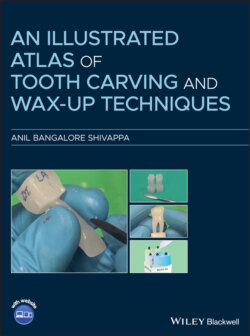Читать книгу An Illustrated Atlas of Tooth Carving and Wax-Up Techniques - Anil Bangalore Shivappa - Страница 12
Оглавление1 Introduction to Dental Anatomy
LEARNING OBJECTIVE
The student should be able to know the definition of dental anatomy, types of dentition, dental formula, and various tooth numbering systems.
Definition of Dental Anatomy
Dental anatomy is defined as the study of the development, morphology, function, and identity of each of the teeth in human dentition [1].
Types of Human Dentition
There are two types of dentition throughout the life of a human being: deciduous dentition and permanent dentition [1]. Deciduous dentition is also called dentition of childhood or primary dentition. This dentition begins prenatally at about 14 weeks in utero. The complete set of teeth in this dentition is seen from years 2–6. Deciduous dentition consists of 20 teeth, 10 in the upper arch and 10 in the lower arch [1, 2]. Permanent dentition is also known as dentition of adulthood or secondary dentition or succedaneous dentition. Permanent dentition is composed of 32 teeth, 16 in the upper arch and 16 in the lower. Teeth seen between the deciduous and permanent dentition periods are in the transition or mixed dentition period [2]. The transition period lasts from about 6–12 years of age and ends when all the deciduous teeth are shed [1].
Arch
The arch formed by the teeth and upper jawbone is the maxillary arch. The arch formed by the teeth and lower jawbone is the mandibular arch. Both the maxillary and the mandibular arches have right and left halves known as quadrants [2].
Quadrants
Each dentition is divided into four quadrants named clockwise as upper right, upper left, lower left, and lower right. The left and right quadrants on both jaws are divided by the midsagittal plane so that the upper right quadrant mirrors the upper left quadrant and the lower right quadrant mirrors the lower left quadrant. Within each quadrant there are four classes of teeth: incisors (central and lateral), canines, premolars (first and second), and molars (first, second, and third) [3].
Dental Formula
For Primary Dentition
This formula (Figure 1.1) should be read as two incisors in the maxilla and two incisors in the mandible, one maxillary canine and one mandibular canine; two maxillary and two mandibular molars, altogether 10 on one side, either right or left side [2].
For Permanent Dentition
The dental formula for permanent dentition (Figure 1.2) is read as two incisors in the maxilla and two incisors in the mandible, one maxillary canine and one mandibular canine, two maxillary and two mandibular premolars, three maxillary and three mandibular molars [2].
Figure 1.1 Dental formula for deciduous dentition.
Figure 1.2 Dental formula for permanent dentition.
Tooth Notation
Universal System
In the universal system for primary dentition (Figure 1.3) uppercase letters are used starting from A through J (starting from the right maxillary second molar to the left maxillary second molar) for maxillary teeth and from letters K through T (beginning from the left mandibular second molar ending at the right mandibular second molar) for mandibular teeth [2].
In the universal notation system for permanent dentition (Figure 1.4), numbers from 1 through 32 are used for the full set of teeth. The maxillary teeth are numbered from 1 through 16 (beginning from the right maxillary third molar as tooth no. 1 ending at the left maxillary third molar as tooth no. 16). Mandibular teeth are numbered from 17 through 32 (beginning from the left mandibular third molar as tooth no. 17, ending at the right mandibular third molar as tooth no. 32) [2].
Zsigmondy Palmer Notation
In this system both the maxillary and mandibular arches are divided into two quadrants, so that there are a total of four quadrants in the oral cavity, each quadrant with a set of teeth as follows [2, 3]:
Figure 1.3 Universal system for primary dentition.
Figure 1.4 Universal system for permanent dentition.
For Primary Teeth
In each quadrant capital letters are used to denote teeth, from A (for central incisor) to E (for second molar); see Figure 1.5 [2].
For Permanent Teeth
In each quadrant, numbers are used to denote teeth from 1 (for central incisor) to 8 (for third molar); see Figure 1.6 [2, 3].
Figure 1.5 Zsigmondy Palmer notation for primary dentition.
Figure 1.6 Zsigmondy Palmer notation for permanent dentition.
FDI System
A two‐digit system proposed by Fédération Dentaire Internationale (FDI): In this system, the first number indicates the quadrant and the second number indicates a particular tooth (Figures 1.7 and 1.8) [2, 3].
For the Permanent Teeth
Figure 1.7 FDI system for primary dentition.
For the Primary Teeth
Figure 1.8 FDI system for permanent dentition.
References
1 1 Stanley, J.N. and Major, M.A. C. (2010). Wheeler's Dental Anatomy and Occlusion, 9e. St. Louis, MO: Saunders Elsevier.
2 2 Rickne, C.S. and Weiss, G. (2012). Woelfel's Dental Anatomy, 8e. Philadelphia: Lippincott Williams & Wilkins.
3 3 Hillson, S. (2012). Dental Anthropology. Cambridge University Press. Kindle Edition.
